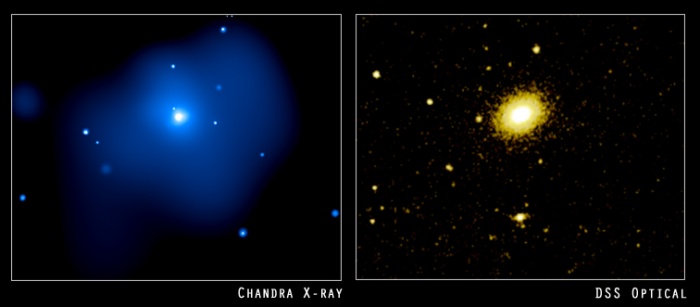Displaying image 117 of 363 images in Astronomy.
NGC 4555: Chandra's Find of Lonely Halo Raises Questions About Dark Matter
The Chandra image of NGC 4555 revealed that this large, isolated, elliptical galaxy is embedded in a cloud of 10-million-degree Celsius gas (left). The hot gas cloud has a diameter of about 400,000 light years, roughly twice that of the visible galaxy (right).
Astronomers have concluded that the combined gravity of the stars in the galaxy is far too low to hold the hot gas cloud to the galaxy - an enormous envelope, or halo, of dark matter is needed. The total mass of the required dark matter halo is about ten times the combined mass of the stars in the galaxy, and 300 times the mass of the hot gas cloud.
A growing body of evidence indicates that dark matter - which interacts with itself and normal matter only through gravity - is the dominant form of matter in the universe. According to the popular "cold dark matter" theory, dark matter consists of mysterious particles left over from the dense early universe that were moving slowly when galaxies and galaxy clusters began to form.
Most large, elliptical galaxies are found in groups and clusters of galaxies where they can gain or lose dark matter through collisions with other galaxies, so it is difficult to determine how much dark matter they originally possessed. The Chandra observation of NGC 4555 confirms that an isolated, elliptical galaxy can possess a dark matter halo of its own.
Fast Facts for NGC 4555:
Credit: X-ray: NASA/CXC/E.O'Sullivan et al; Optical: Palomar DSS
Scale: Image is 8 x 6.5 arcmin across.
Category: Normal Galaxies & Starburst Galaxies
Coordinates (J2000): RA 12h 35m 41.20s | Dec +26° 31' 23.20"
Constellation: Coma Berenices
Observation Dates: February 4, 2003
Observation Time: 8 hours
Obs. IDs: 2884
Color Code: Intensity
Instrument: ACIS
References: E. O'Sullivan, November 1, 2004, Monthly Notices of Royal Astronomical Society, and astro-ph 0407552
Distance Estimate: 300 million light years
Release Date: October 26, 2004
Source: http://chandra.harvard.edu/photo/2004/ngc4555/



 Searching...
Searching...

 Previous
Previous
 Next
Next